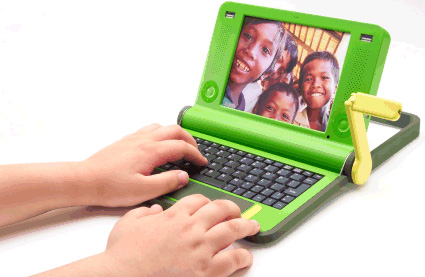Werner
Object From The Future
The 100 Dollar Laptop
The $100 laptop is an ultra-low-cost, full-featured computer designed to dramatically enhance children's primary and secondary education worldwide. It is the central project of the nonprofit One Laptop per Child (OLPC) association, which aims to equip the world's schoolchildren and their teachers with a personal, portable, connected computer.

The project was proposed in January 2005 at the World Economic Forum in Davos, Switzerland by Nicholas Negroponte, co-founder of MIT Media Lab. The idea is that governments pay roughly $100 for the laptops and distribute them for free to students in the lesser developed nations. The idea was very popular and in the months after the Forum, Negroponte and his nonprofit association devoted time and effort into getting the necessary parties on-board in order to create a prototype. U.N. Secretary-General Kofi Annan unveiled the first working prototype of the $100 laptop November 16th at the World Summit on the Information Society in Tunis.
Replace
Why would children in developing nations benefit from using laptops in school ? For one, there is the informational benefit; children can access a wealth of knowledge online. OLPC makes a comparison to a community pencils as opposed to community internet-access centers; 'They are tools to think with, sufficiently inexpensive to be used for work and play, drawing writing and mathematics. A computer can be the same but far more powerful. The problem of connectivity is currently being investigated. According to OLPC, a lot of organizations are interested in aiding in financing internet connections in developing nations. The first and foremost means of connectivity at the moment is the mesh network these laptops can make with each other.
Change
According to Nicholas Negroponte, 'Children are the greatest natural resource of any country, and educating these children is at the root of solving our largest and most complex problems.' Nicholas continues, 'Yet the best education may not come from sitting in a traditional classroom, but rather through independent interaction and exploration. The development of a $100 laptop will now make this possible for all kids -- especially those in developing nations. It will redefine how we 'learn learning.' ' The tactic that OLPC is going to use is that of a grassroots movement. The software that is being used is all Open Source, OLPC aims for a mass movement in line with Linux and Wikipedia.
Growth
At the moment, a few prototypes have been created for press and negotiation purposes. Five companies are working with MIT to develop an initial 5 million to 15 million test units within the year. These companies are Google, Advanced Micro Devices, News Corp., Red Hat and BrightStar. The current plan is to produce 100 million to 150 million units by 2007.
While the initial goal of the project is to work with governments, MIT is considering licensing the design or giving it to a third-party company to build commercial versions of the PC. Those might be available for $200, and about $30 will come back to OLPC to make the kids' laptops. This is still in consideration.
References
Driving forces
Driving Force: One Million Dollar Laptop
Driving Force: Increacing Healthy Life Expectancy
Werner
May 13th, 2006